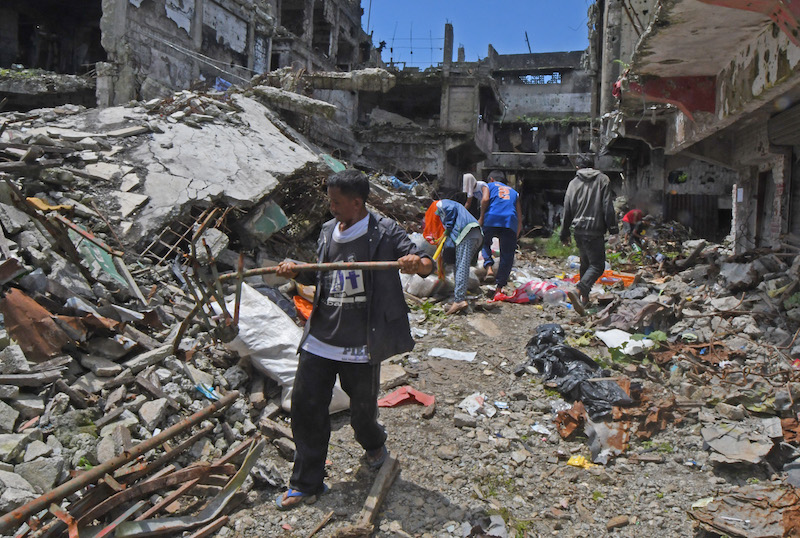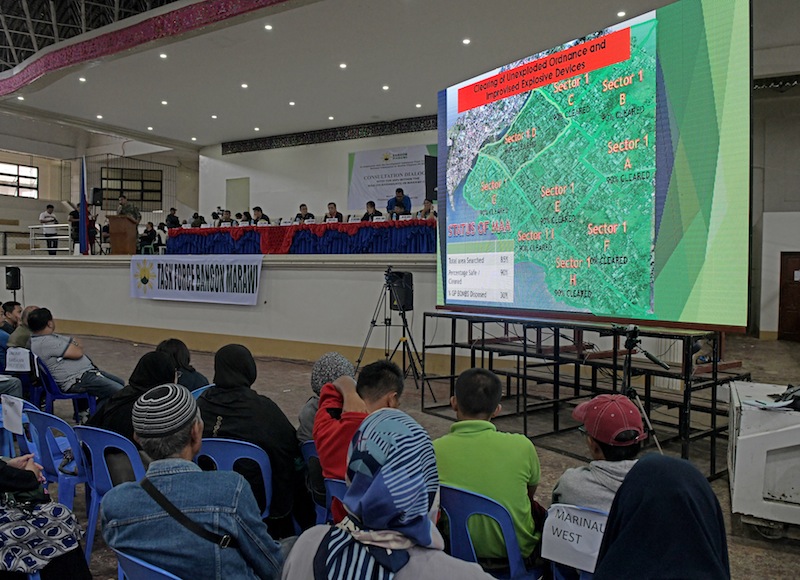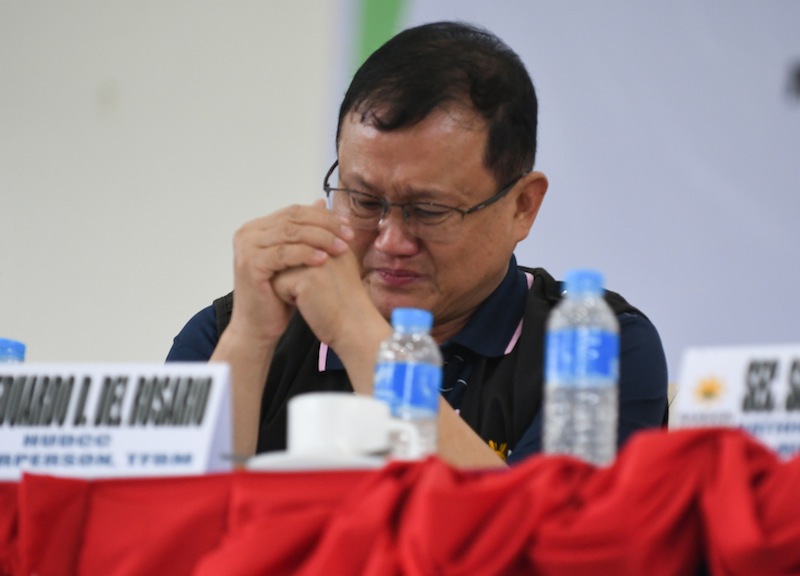KORONADAL CITY (MindaNews / 10 July) – A lawyer in Marawi claims at least four villages – straddling about 16 hectares – in the city’s “Ground Zero” have been “sequestered” by the government to host several construction projects to restore the city’s old glory, an allegation the mayor said is “not true.”
 Residents scavenge what is left of their homes and commercial buildings in Marawi City’s ‘Ground Zero.’ MindaNews file photo by FROILAN GALLARDO
Residents scavenge what is left of their homes and commercial buildings in Marawi City’s ‘Ground Zero.’ MindaNews file photo by FROILAN GALLARDO
Lawyer Ibrahim Mimbalawag, a resident of Marawi, said landowners and residents could apparently no longer return to the four villages as the National Housing Authority (NHA) and the Marawi local government unit have allocated them for infrastructure projects to rehabilitate the country’s lone Islamic city.
“Haharangin namin ito (We will block this) …. We will file a legal action in the court,” Mimbalawag said Friday in “Alerto Bangsamoro,” a radio program aired over the Oblate-owned DXMS Radyo Bida in Cotabato City.
He identified the barangays as Datu sa Dansalan, Dansalan, Sabala Amanao and Datu Naga.
In an earlier social media post, Mimbalawag said his family discovered that landowners and residents of the four villages could not return to the Most Affected Area (MAA, another name for Marawi’s Ground Zero) after his sister tried to pay the real property tax for their land located in Barangay Datu sa Dansalan.
“To her shock and dismay, she was informed by the Assessor’s Office that they may no longer collect taxes because our private lands inside MAA were covered by government rehabilitation projects,” he wrote.
On 1 July 2021, Mimbalawag said he went with his mother and sister to the Task Force Bangon Marawi (TFBM) to clarify the matter, but were referred to the NHA and the LGU Marawi.
 The Task Force Bangon Marawi meets with residents of ‘Ground Zero.’ MindaNews file photo by FROILAN GALLARDO
The Task Force Bangon Marawi meets with residents of ‘Ground Zero.’ MindaNews file photo by FROILAN GALLARDO
They proceeded to the NHA’s office in the city and were told that the four villages would be utilized for the building of government rehabilitation projects such as convention center, grand padian (market) and promenade, among others, he added.
Mimbalawag said they were shocked when told by an NHA personnel that private land owners and residents of the four villages can no longer go back to their titled lots to rebuild their houses because government rehabilitation projects will be built in those villages.
During Friday’s radio guesting, the lawyer appealed to the NHA and the Marawi LGU to construct the rehabilitation projects on vacant lots in the city and allow the legitimate land owners and residents to return and rebuild their properties in the MAA.
Marawi Mayor Majul Gandamra denied Mimbalawag’s allegations. In a telephone interview on Saturday, he denied the four villages were sequestered. He said barangay halls, health centers and a madrasah are being constructed in each village. He added that residents in these four villages, like the rest of the 24-village Ground Zero, can return to rebuild their homes after applying for building permits.
Gandamra said the government projects Mimbalawag referred to, including the Grand Padian (market), convention and sports center, are being constructed within the reclamation area of at least 10 hectares that government owns. He said this was the site of the market, city mall and ice plant before the siege.
He explained that before the siege, some individuals were able to construct private structures within the reclamation area because “previous administrations tolerated them.” He said the city government is undertaking reforms including ensuring land titling, payment of real property taxes, applying for business permits and building permits.
Jorge Golle, senior program officer for digital information and mapping at International Alert Philippines, one of the sponsors of the “Alerto Bangsamoro” radio program, noted that one of the major concerns that needs to be ironed out is the boundary issue that the NHA and the Marawi LGU used.
“Whose map shall prevail? The NHA or the Marawi LGU?” he asked.
If the NHA map will prevail, 81 land titles would be affected but this would increase to 114 land titles if the Marawi LGU map will be followed, he said.
Golle said the four villages are located along the lake and served as the “last battleground” between the military and the Islamic militants during the five-month war four years ago.
He noted that the four villages have been cleared and various construction projects are ongoing in the area, which has been designated, according to locals, as the “local/national government center.”
Mimbalawag said there was an apparent lack of intensive public consultation by the government with the landowners that’s why the problem worsened, noting that several residents have land titles to prove ownership.
TFBM chair Eduardo del Rosario has repeatedly denied that there had been lack of consultations in the rehabilitation of Marawi.
 Task Force Bangon Marawi chair Eduardo del Rosario gets emotional after a deluge of complaints from residents. MindaNews file photo by FROILAN GALLARDO
Task Force Bangon Marawi chair Eduardo del Rosario gets emotional after a deluge of complaints from residents. MindaNews file photo by FROILAN GALLARDO
He also previously assured that “titled and non-titled properties occupied by residents will be given back to them by the government.”
TFBM profiles all land properties inside MAA to identify the legitimate landowners and the boundaries of each property, a report posted at the Bangon Marawi website in April 2019 said.
In a virtual presser on July 8, Del Rosario said that a year after the construction of public infrastructure started in July 2020, “the completion rate is about 68%.”
The TFBM, which is composed of 56 government agencies, “remains to be on track and will substantially be completed by December of 2021 and will be totally completed within the term of President Rodrigo Roa Duterte.” But Jalilah Sapiin, a member of the Marawi Reconstruction Conflict Watch, stressed that land rights have become a major contentious problem in the rehabilitation of Marawi until now.
“The problem was made worse because from the beginning, it was not addressed. There are discrepancies in the data of the NHA and the LGU,” she said.
Sapiin said that MAA residents continue to yearn to return and rebuild their properties four years after they were displaced.
As of January 2021, 17,555 families or 87,775 individuals remained displaced due to the Marawi siege in May 2017, according to data from the Office of the United Nations High Commissioner for Refugees.
Sapiin asked the Ministry of Environment, Natural Resources and Energy of the Bangsamoro Autonomous Region in Muslim Mindanao to help settle the problem of the landowners and residents in Marawi, the capital of Lanao del Sur, one of the five provinces in the Bangsamoro region.
In 2017, at least 350,000 civilians were uprooted after the Islamic State-aligned Maute and Abu Sayyaf groups seized Marawi in a bid to establish it as a ‘”wilayah” or Islamic state in Southeast Asia.
The five-month urban warfare destroyed the core of Marawi, now known as the MAA, and left, according to the military, some 1,100 individuals dead, mostly Islamic militants.
The rehabilitation of Marawi was estimated to cost the government P75 billion. (Bong S. Sarmiento / MindaNews with a report from Carolyn O. Arguillas)
